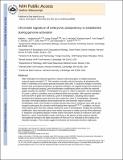Chromatin signature of embryonic pluripotency is established during genome activation
Author(s)
Vastenhouw, Nadine L.; Zhang, Yong; Woods, Ian G.; Imam, Farhad; Regev, Aviv; Liu, X. Shirley; Rinn, John L.; Schier, Alexander F.; ... Show more Show less
DownloadRegev_Chromatin signature.pdf (922.4Kb)
OPEN_ACCESS_POLICY
Open Access Policy
Creative Commons Attribution-Noncommercial-Share Alike
Terms of use
Metadata
Show full item recordAbstract
After fertilization the embryonic genome is inactive until transcription is initiated during the maternal–zygotic transition. This transition coincides with the formation of pluripotent cells, which in mammals can be used to generate embryonic stem cells. To study the changes in chromatin structure that accompany pluripotency and genome activation, we mapped the genomic locations of histone H3 molecules bearing lysine trimethylation modifications before and after the maternal–zygotic transition in zebrafish. Histone H3 lysine 27 trimethylation (H3K27me3), which is repressive, and H3K4me3, which is activating, were not detected before the transition. After genome activation, more than 80% of genes were marked by H3K4me3, including many inactive developmental regulatory genes that were also marked by H3K27me3. Sequential chromatin immunoprecipitation demonstrated that the same promoter regions had both trimethylation marks. Such bivalent chromatin domains also exist in embryonic stem cells and are thought to poise genes for activation while keeping them repressed. Furthermore, we found many inactive genes that were uniquely marked by H3K4me3. Despite this activating modification, these monovalent genes were neither expressed nor stably bound by RNA polymerase II. Inspection of published data sets revealed similar monovalent domains in embryonic stem cells. Moreover, H3K4me3 marks could form in the absence of both sequence-specific transcriptional activators and stable association of RNA polymerase II, as indicated by the analysis of an inducible transgene. These results indicate that bivalent and monovalent domains might poise embryonic genes for activation and that the chromatin profile associated with pluripotency is established during the maternal–zygotic transition.
Description
available in PMC 2011 April 8.
Date issued
2010-03Department
Massachusetts Institute of Technology. Department of BiologyJournal
Nature
Publisher
Nature Publishing Group
Citation
Vastenhouw, Nadine L. et al. “Chromatin Signature of Embryonic Pluripotency Is Established During Genome Activation.” Nature 464.7290 (2010): 922–926. Web.
Version: Author's final manuscript
ISSN
0028-0836
1476-4687